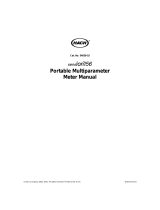High conductivity zone: When the measurement frequency is low, the surface of the electrodes will
very quickly saturate and form an insulating layer reducing the flow of current, a phenomenon known
as polarization. Set the frequency to 1 kHz.
Note: Select the Auto option to automatically adjust the frequence according to the measurement range.
Set the type of temperature compensation
The conductivity of a solution depends both on the concentration and mobility of the ions. The
temperature of the solution has an influence on these two factors and favors the dissociation of the
molecules and therefore the ionic concentration, and increases the mobility.
In order to allow the comparison between measurements made at different temperatures, this
measurement needs to be brought back to a reference temperature (generally 25 °C).
On the PROGRAMMING-MEASURE-TEMP.COMP. menu, set the temperature compensation type
according to the sample characteristics.
Probe calibration
For detailed information regarding transmitter programming, please refer to the user manual
delivered with the transmitter.
Note: It is advisable to calibrate the temperature before the conductivity probe.
Temperature calibration
This is an important step during commission to take into account the cable resistivity and the
temperature compensation.
1. Immerse the probe in a solution for about 10 minutes.
2. Record the temperature of the solution with a thermometer (precision < ± 0.1°C).
3. Program the transmitter in process calibration mode.
4. Adjust the value of the temperature read with that of the thermometer.
Conductivity calibration
First method (recommended)
1. Program the transmitter in electric calibration mode. Choose the resistance the closest possible
to your process (see table below).
2. First point: Remove the probe from the liquid or unscrew the connector from the probe.
3. Second point: Connect the resistance (precision < 0.1 %) of the same value programmed at the
IN/OUT terminals of the conductivity module.
Conductivity solution:
Resistivity solution:
0.1 μS.cm
-1
10 MΩ.cm
10 μS.cm
-1
0.1 MΩ.cm
R connected for K= 0.01 cm
-1
100 kΩ 1 kΩ
R connected for K= 0.1 cm
-1
N/A 10 kΩ
R connected for K= 1 cm
-1
N/A 100 kΩ
Conductivity solution:
Resistivity solution:
1 mS.cm
-1
1 kΩ.cm
10 mS.cm
-1
100 Ω.cm
R connected for K= 0.01 cm
-1
N/A N/A
R connected for K= 0.1 cm
-1
100 Ω N/A
R connected for K= 1 cm
-1
1 kΩ 100 Ω
10 English




















